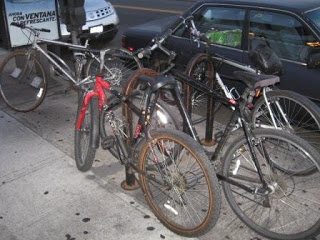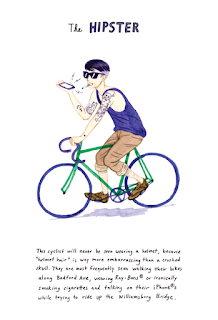I have long said that much of the opposition to bicycle infrastructure--or simply encouraging people to get out of their cars and onto a saddle--is really class-based resentment. In other words, people who are upset when they see bike share docks taking up "their" parking spaces or a bike lane that takes "their" traffic lane away believe that liberal elites are coddling privileged young people who are indulging in a faddish pastime and simply won't grow up.
What they fail to realize is that creating awareness and infrastructure doesn't just protect trust fund kids who ride their "fixies" to trendy cafes where they down $12 craft beers. A goal of efforts to encourage cycling and make it safer is also to protect those who, by necessity, make their livings on their bicycles. Edwin Vicente Ajacalon was one of them.
Like most of the folks who make food deliveries on their bicycles, Ajacalon was an immigrant--in his case, from Guatemala. He arrived in this country--specifically, to Brooklyn--a year ago.
He did not, however, live in the Brooklyn of fixed gears and craft beers: Though he was only about eight kilometers from Hipster Hook, he lived a world away, in a single room he shared with five other men who, like him, are immigrants who delivered food by bicycle. And the area in which he usually worked, which realtors dubbed "Park Slope South" some years back, is really still the hardscrabble working-class immigrant community it was when my mother was growing up in it. The only differences are, of course, that the immigrants come from different places and that the neighborhood--hard by the northwestern entrance of the Greenwood Cemetery--is dirtier and shabbier, and still hasn't entirely recovered from the ravages of the 1980s Crack Epidemic.
Only one block from that entrance to the necropolis, around 5:45 pm on Saturday, Edwin Vicente Ajacalon was pedaling through the intersection of Fifth Avenue and 23rd Street. There, a BMW sedan smacked into him.
The driver, to his credit, remained at the scene (and has not been charged with any crime). Unfortunately, there probably was nothing he or anyone else could do for Edwin: Minutes later, the police would find him lying down in a pool of blood, halfway across the block from where he was hit. Someone checked his vital signs and found none, which means that, although he was pronounced dead when he arrived at the hospital, he might've died as soon as the car struck him or when he struck the pavement.
All anyone could do after that was to pick up the pieces of his bicycle which, along with a sneaker and a hat, where strewn about the street.
When anyone dies so suddenly and tragically, we can lament the loved ones who will never see him again, and those whom he will never see--as well as the things he won't have the opportunity to do. For poor Edwin, those things include celebrating his fifteenth birthday.
Yes, you read that right. Edwin Vicente Ajacalon was 14 years old when he was struck and killed while making deliveries on his bicycle--one year after emigrating, alone, from Guatemala. He has no family here in the US, save for an uncle with whom he briefly lived. Like his roommates, Edwin was working other odd jobs in addition to delivering food on his bicycle--and, after paying rent, sending money to his parents in Guatemala.
So...Now we know that bicycle safety is not just a matter of protecting pampered post-pubescents. In this case, it's about protecting the livelihood of a boy in his early teens and the parents he was trying to support. And they can't even afford to come to the US to claim his body.
What they fail to realize is that creating awareness and infrastructure doesn't just protect trust fund kids who ride their "fixies" to trendy cafes where they down $12 craft beers. A goal of efforts to encourage cycling and make it safer is also to protect those who, by necessity, make their livings on their bicycles. Edwin Vicente Ajacalon was one of them.
Like most of the folks who make food deliveries on their bicycles, Ajacalon was an immigrant--in his case, from Guatemala. He arrived in this country--specifically, to Brooklyn--a year ago.
He did not, however, live in the Brooklyn of fixed gears and craft beers: Though he was only about eight kilometers from Hipster Hook, he lived a world away, in a single room he shared with five other men who, like him, are immigrants who delivered food by bicycle. And the area in which he usually worked, which realtors dubbed "Park Slope South" some years back, is really still the hardscrabble working-class immigrant community it was when my mother was growing up in it. The only differences are, of course, that the immigrants come from different places and that the neighborhood--hard by the northwestern entrance of the Greenwood Cemetery--is dirtier and shabbier, and still hasn't entirely recovered from the ravages of the 1980s Crack Epidemic.
Only one block from that entrance to the necropolis, around 5:45 pm on Saturday, Edwin Vicente Ajacalon was pedaling through the intersection of Fifth Avenue and 23rd Street. There, a BMW sedan smacked into him.
The driver, to his credit, remained at the scene (and has not been charged with any crime). Unfortunately, there probably was nothing he or anyone else could do for Edwin: Minutes later, the police would find him lying down in a pool of blood, halfway across the block from where he was hit. Someone checked his vital signs and found none, which means that, although he was pronounced dead when he arrived at the hospital, he might've died as soon as the car struck him or when he struck the pavement.
All anyone could do after that was to pick up the pieces of his bicycle which, along with a sneaker and a hat, where strewn about the street.
When anyone dies so suddenly and tragically, we can lament the loved ones who will never see him again, and those whom he will never see--as well as the things he won't have the opportunity to do. For poor Edwin, those things include celebrating his fifteenth birthday.
Yes, you read that right. Edwin Vicente Ajacalon was 14 years old when he was struck and killed while making deliveries on his bicycle--one year after emigrating, alone, from Guatemala. He has no family here in the US, save for an uncle with whom he briefly lived. Like his roommates, Edwin was working other odd jobs in addition to delivering food on his bicycle--and, after paying rent, sending money to his parents in Guatemala.
So...Now we know that bicycle safety is not just a matter of protecting pampered post-pubescents. In this case, it's about protecting the livelihood of a boy in his early teens and the parents he was trying to support. And they can't even afford to come to the US to claim his body.














